Nepal
Water Induced Disasters in Nepal: Recent Trends and Measures
Shital Babu Regmee *
Introduction
Nepal, occupying the central part of the Hindu-Kush Himalayan belt, covers an area of 147,181 square kilometer between India and China. On an average it extends about 900 km in east- west and 200 km in north-south direction. The altitude ranges from below 60 m to more than 8000 m in the Himalayas. The terai plain occupies about 20% of the total area of the country and the rest is hills and mountains. Geologically and ecologically the country can be divided into five distinct regions namely the Terai, Siwalik Hills, Middle Mountains, High Mountains and High Himalayas.
The average annual precipitation is around 1600 mm of which almost 80% occurs during the period of June-September. The variation ranges from less than 300 mm in the rain shadow dry region to around 5000mm in the wet region. On the physical side, rugged topography, young geology and monsoon climate, all combine to produce high rate of runoff, erosion and sedimentation. At times, tremendous natural forces as earthquakes, floods and landslides are unleashed. Human activities have also resulted in pressure on biophysical resources of the country. Such natural features associated with intense monsoon rainfall as well as human interventions render the country highly vulnerable to water induced disasters such as floods, landslides, debris flow etc. demanding effective and sustainable countermeasures.
Fragile geological, formation, steep topography, high intensity rainfall, drainage congestion etc. make Nepal's eco-system very delicate. Floods, landslides, debris flows have been a common feature and has become a matter of great concern for human security, livelihood and sustainability of infrastructures developed. Figure 1 shows simplified geologic cross section of Nepal.
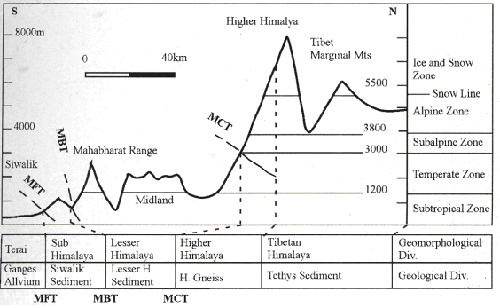
Figure 1: Simplified Physiographic and Geologic Cross-section of the Himalaya along with corresponding Climatic Zones.
The River Systems of Nepal
* Shital Babu Regmee is Acting Executive Secretary, Water and Energy Commission Secretariat
About 6000 rivers drain Nepal. These rivers are broadly classified into three categories based on the nature of their source and discharge.
In the first category are perennial rivers that originate in the Himalayas and carry snow fed flows with significant discharge even in the dry season. This includes the Koshi, Gandak, Karnali and Mahakali river systems.
In the second category are the rivers, which originate in the midlands of Mahabharat range of mountains and are fed by precipitation as well as ground water regeneration, including springs. Mechi, Kankai, Kamala, Bagmati, West Rapti and Babai rivers fall under this category. Although these rivers are also perennial, they are commonly characterized by wide seasonal fluctuations in discharge.
The third category of river systems includes a large numbers of small rivers in the terai, which originate from the southern Siwalik range. These rivers are seasonal and are characterized by flash floods during the monsoon and little or no discharge during dry season. They drain the areas between basins covered by large and medium rivers. Figure 2. shows river systems of Nepal.
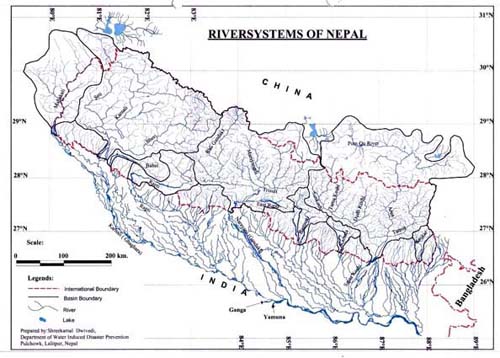
Figure 2: River systems of Nepal
Policies
Establishment of a separate and permanent institution for dealing with water induced disaster indicates the priority given by the government of Nepal for addressing the problem. Traditional concept on disaster used to be rather conservative: defining it to be the act of nature. Traditional concept, especially in south Asia, expected the people to tolerate the effect caused by the disasters. Institutions paid less attention to the suffering of people due to such calamities. Recently they are recognized as a mandatory job of the country and it is getting attention of planners and policy makers. In Nepal, too, new policies and plans are including disaster mitigation as a mandatory means for the sustainable development planning.
With the mandate given by the Water Resources Strategy, 2002 Ministry of Water Resources, Nepal has prepared a “Water Induced Disaster Management Policy (DMP), 2005”nand is in the final stage of approval by the Government. The Policy has the following goals.
Protection of life and property from disasters like flood and landslide.
Sustainable development of natural resources and sustainable utilization of infrastructures developed.
Reclamation of land effected from calamities and utilize the same for rehabilitation of landless and in other economical and social activities.
Institutional development for water induced disaster management and flood affected area management.
Streamline the activities of different government and non-government organizations so that duplication of resources and services is minimized.
To achieve the goals as mentioned above policy adopted are:
a) Emergency protection
Information related to river, basin area, hazard zones etc shall be studied and incorporated with hydro-meteorological data and shall be disseminated so that the relief, rescue and protection activity becomes more effective.
To make local people have knowledge about measures to be adopted during emergency awareness raising activities and practices shall be adopted.
Ware houses shall be established in different locations so that emergency materials are available easily in time of need. A water induced disaster rehabilitation fund shall also be established.
b) Water induced disaster mitigation
WID effected areas shall be categorized as highly vulnerable, moderately vulnerable, and safe areas. Standards shall be set for the infrastructures to be developed in affected areas.
Public participation and community mobilization shall be encouraged. Master plan shall be prepared for different river basins and implemented on priority basis.
Possible flood and landslide affected shall be categorized and activities e.g. residence, industry, agriculture, other economic and social activities area shall be defined. Relocation of such activities shall be done if necessary.
c) Natural resource conservation
Conservation of watershed area shall be made essential and integral part for the development of any infrastructure in the area. Protection of environment shall be given high priority. For this vegetative and bioengineering works shall be given high priority.
d) Utilization of flood plains.
Activities like agriculture, forestry, parks shall be suggested for vulnerable areas and residence, industry, school, hospitals in less vulnerable areas.
Participation from private sector involvement shall be allowed and encouraged to participate in the activities of WID mitigation. The land thus reclaimed can be utilized by the promoter based on the agreement with the government.
e) Institutional arrangement
DWIDP shall be entrusted for collection and dissemination of warning systems, setting out standards, preparation of directives, preparation of hazard maps, issuing of permit for reclamation of land etc. Ministry of Water Resources and Water and Energy Commission Secretariat shall be responsible for supervision and monitoring works.
DWIDP and other related institutions e.g. universities, research agencies shall collaborate for technology development for water induced disaster mitigation works. Technology developed shall be incorporated in the directives.
Capacity of government agencies, non government agencies, local bodies, private sectors shall be enhanced. Special attention shall be giver for the capacity enhancement of local community.
Institutional Setup
Realizing the need of more focused efforts on water induced disaster prevention; His Majesty’s Government of Nepal established ‘Department of Water Induced Disaster Prevention (DWIDP)’ on February 7, 2000 in order to carry out flood mitigation works, landslide and slope stabilization works as well as all other water induced disaster rehabilitation and management activities in the country.
Functions
DWIDP is currently undertaking structural as well as non-structural programs for mitigation of water induced disasters.
Structural measures
There are various activities being executed by this department which are briefed as follows:
Emergency Protection Works
This activity is related to immediate flood response or flood fighting. This work is generally done in locations where the flood is eroding or overflowing the banks or a landslide is being triggered or protection are needed after landslides or existing river training infrastructures are being damaged during flood.
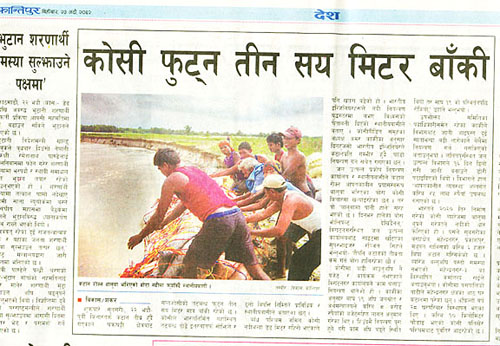
Figure 3: Emergency work in Koshi River (Source: Kantipur Daily)
Rehabilitation Works
There are numerous specific points where flood disasters occur in small and large rivers every year and are normally cannot be taken care of immediately after disaster events. Upon request of the affected people for rehabilitation works, these locations are studied in detail in the dry season subsequent to the disaster events. The requests are prioritized on the basis of severity of damage, people’s participation and the resources available.
Works Under Master Plan
These are the programs being carried out on regular basis for the rivers mentioned in the Tenth Plan. Majority of the activities under this category of program is being run to address location specific problems in a particular river. Efforts are being made for detailed study and prepare the master plans. Once the plans are in place these programs will gradually be amalgamated in the master plans.
Non-structural measures
DWIDP is also implementing non-structural measures.
Training
Various training programs are conducted by the department. Trainings are provided to general public, professionals working in the field of disasters and other stakeholders.
Seminars and workshops
To disseminate information related to disasters and to raise general awareness of the public at large, seminars and workshops are integral part of. National and International seminars are conducted to share experiences among the experts on disaster mitigation. Similarly roving seminars are conducted annually at selected districts in Nepal to raise awareness of general people, local leaders, teachers and government officers on disaster preparedness, response and rehabilitation.
Education/ curricula development
Realizing that children are the most important part of awareness raising in community on disaster mitigation, the department has introduced Disaster Mitigation Education (DME). Under this activity, children of class five studying in the model site areas are given disaster mitigation education.
Publication
The department reviews the water induced disasters events annually and publishes bulletins, reviews, reports, research papers etc. ‘Disaster Review’, published annually includes information on loss of lives and damages to property due to various disasters. Continuous record of disaster related data starting 1983 is being published every year Table 1 provides the data on the disasters in Nepal.
| YEAR | PEOPLE | LIVESTOCK LOSS (Nos.) |
HOUSES DESTROYED (Nos.) |
AFFECTED FAMILY (Nos.) |
LAND AFFECTED (Ha.) |
PUBLIC INFRASTRUCTURE |
ESTIMATED DIRECT LOSS (Million NRs.) |
|
|---|---|---|---|---|---|---|---|---|
| DEATH | INJURED | |||||||
| 1983 | 293 | NA | 248 | NA | NA | NA | NA | 240 |
| 1984 | 363 | NA | 3114 | 7566 | NA | 1242 | 869 | 37 |
| 1985 | 420 | NA | 3058 | 4620 | NA | 1355 | 173 | 58 |
| 1986 | 315 | NA | 1886 | 3035 | NA | 1315 | 436 | 16 |
| 1987 | 391 | 162 | 1434 | 33721 | 96151 | 18858 | 421 | 2000 |
| 1988 | 342 | 197 | 873 | 2481 | 4197 | NA | NA | 1087 |
| 1989 | 700 | 4 | 297 | 6203 | NA | NA | NA | 29 |
| 1990 | 307 | 26 | 314 | 3060 | 5165 | 1132 | NA | 44 |
| 1991 | 93 | 12 | 36 | 817 | 1621 | 283 | 25 | 21 |
| 1992 | 71 | 17 | 179 | 88 | 545 | 135 | 44 | 11 |
| 1993 | 1336 | 163 | 25425 | 17113 | 85254 | 5584 | NA | 4904 |
| 1994 | 49 | 34 | 284 | 569 | 3697 | 392 | NA | 59 |
| 1995 | 246 | 58 | 1535 | 5162 | 128540 | 41867.28 | NA | 1419 |
| 1996 | 262 | 73 | 1548 | 14037 | 36824 | 6093.4 | NA | 1186 |
| 1997 | 87 | 69 | 317 | 1017 | 5833 | 6093.4 | NA | 104 |
| 1998 | 273 | 80 | 982 | 13990 | 33549 | 326.89 | NA | 969 |
| 1999 | 209 | 92 | 309 | 2538 | 9768 | 182.4 | NA | 365 |
| 2000 | 173 | 100 | 822 | 5417 | 15617 | 888.9 | NA | 932 |
| 2001 | 196 | 88 | 377 | 3934 | 7901 | NA | NA | 251.1 |
| 2002 | 441 | 265 | 2024 | 18181 | 39309 | 10077.5 | NA | 418.91 |
| 2003 | 232 | 78 | 865 | 3017 | 7167 | NA | NA | 234.78 |
| 2004 | 131 | 24 | 495 | 3684 | 14238 | 321.82 | NA | 219.28 |
| TOTAL | 6799 | 1516 | 45927 | 146626 | 478438 | 95825.77 | 1968 | 14385.79 |
| AVERAGE | 323.76 | 72.19 | 3187 | 6979.33 | 22911.33 | 4563.13 | 93.71 | 685.03 |
DIS development
DWIDP has also creating district-wise disaster database for all 75 districts using GIS and digital maps of the country. This is expected to strengthen the DWIDP Disaster Information System.
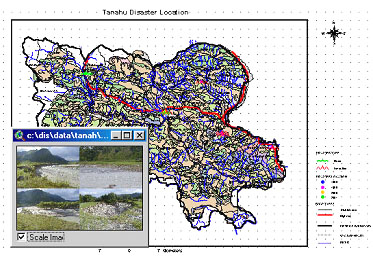
Figure: 4 DIS database of a District
Examples
1. Muglin-Narayanghat Highway
Introduction
The Mugling-Narayanghat Highway, 36 Km long, is probably the most important road connecting the capital city Kathmandu to outside world via Terai. Over 90 % of daily consumer goods, other commodities, industrial raw materials and fuel are being transported through this highway. Obviously, export market of the country heavily depends on it too. Thus, the day to day economy of the country is governed by this very road.
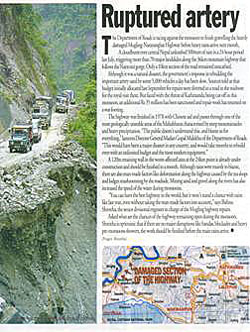
Intense rainfall (446 mm in 24 hours at Devghat, the confluence of Kali Gandaki and Trisuli Rivers) of 30th and 31st July 2003, there triggered numerous landslides, debris flow, slope failure, rock fall and so on along the Mugling-Narayanghat Road Corridor. This event caused road blockade for several weeks; at few locations road was blocked for up to 22 times (Chainage 30 + 890) in this very monsoon season. Emergency measures were taken to open-up the road. However, it remained far from being fully operational causing acute shortage of food and fuel in the capital city affecting 2 million people.
Figure 5: Location map and picture of Mugling-Narayanghat Road .
Disaster Assessment
The concentrated rainfall triggered more than 70 landslides and debris flows along the Mugling-Narayanghat Road Corridor causing widespread damages to the road rendering blockage for weeks. This caused acute shortage of food, fuel, medicine and other essential goods in the capital city of Kathmandu as well as other parts of central region. Severe inconvenience to more than 2 million people thus occurred. Emergency measures were taken to open up the road but it remained still far from being fully operational.
Suitable structural countermeasures like check Dams, Hillside Works Channel Works Spur/Levees, bio-engineering Works are being carried out for mitigating and preventing from disasters triggered by intense rainfall
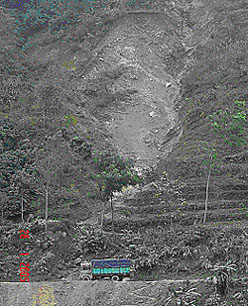
Figure 6 : Site condition before
countermeasure
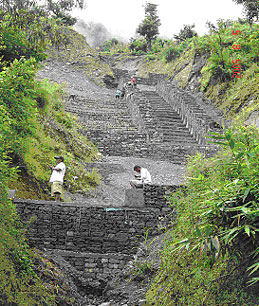
Figure 7 : Site condition after
countermeasure
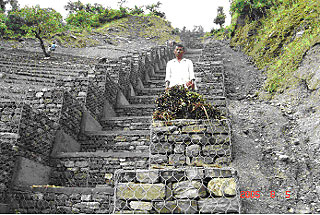
Figure 8 : Gabion cascade with concrete topping counter measure.
2. Lalbakeya River
The Lalbakeya River, flowing through central terai of Nepal, is one of the representative rivers of siwalik group. The river is characterized by sudden rise and fall of flows in response to monsoon storms. The river starts depositing sediment load and splits into a number of channels as soon as it debouches into plain areas. The deposited shoals often become so large that they deflect the flow causing the river channel to shift its position laterally. The situation is further aggravated by widely fluctuating discharges and corresponding sediment load. Consequently, there is always a tendency of the river to shift towards one or the other bank. Bank erosion in the upper reaches and spilling and avulsion in the lower reaches are generally the common problems encountered. In this process the river has formed a wide flood plain and many channels, either active or dry, along its course from foothill to Nepal-India border.
-
Each year thousands of families are affected by flash floods. Lives are lost. Infrastructure and property damaged causing negative impact on the social and economic development of the country.
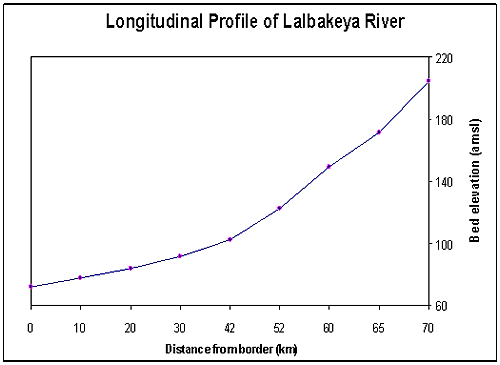
Figure 9 : Longitudinal section of Lalbakeya River
・River Morphology
Like other flashy rivers, the Lalbakeya River starts depositing the sediment load and splits into a number of channels as soon as it debouches into plain area. The deposited shoals often become so large that they deflect the flow causing the channel to shift its position laterally. Comparison of the current river course with those in the past indicates that the change in the river course is appreciable. It is an unstable river with braided channels at several places near foothills.
・Flash Floods
In Nepal, monsoon precipitation and snowmelt from the Himalayas contribute to river flow. Hydrographs of these rivers show no rise in flow until the first monsoon rains. These rivers are characterized by sudden rise and fall of flows in response to monsoon storms. A typical hydrograph of such a river is shown in figure 10.
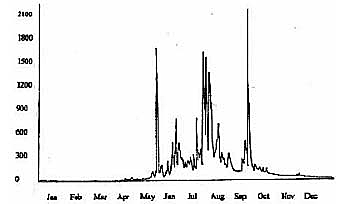
Figure :10 Typical hydrograph of Rivers originating in siwalik (figures are indicative)
Sediment Problem
According to an estimate Nepal is loosing 240 million cubic meter of soil annually, that is equal to 2.38 mm of soil removed from the surface of hills and mountains (excluding snow peak areas and terai). Based on this the annual sediment yield from its basin area comes out to be 2.13 million cubic meter.
While transporting capacity remains high in the hills, deposition process is dominant in the terai plain
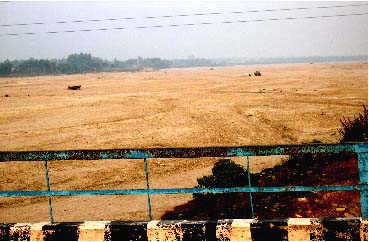
Figure 11 : Heavy sediment deposition in the riverbed
・Flood Problems
General flood problems of such rivers are erosion, sedimentation, avulsion and inundation. Bank erosion in the upper reaches and spilling and consequent inundation in the lower reaches are generally the common problems encountered.
Furthermore, it has been noted that with the ongoing various development works the floodwater that used to flow along the wide flood plains is being forced to flow through definite channels.
・Impacts
The main impacts of flash floods are damage to property, infrastructure and disruption to social and economic activities. According to an estimate about 50% of the total population and a similar proportion of assets are concentrated in flood plains.
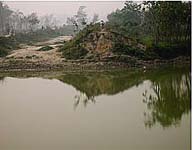
Figure 12 : Canal breached by spilled water
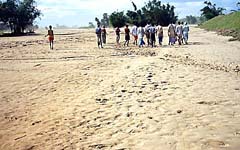
Figure 13 – Heavy siltation on the country side of embankment due to spill from upstream
・Flood Damage Mitigation Measures
Floods are in reality not controlled, they are regulated as far as possible along the course in a manner that damage is avoided or minimized.
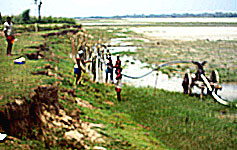
Figure 14 : 7.5 m long Bamboo pile being driven
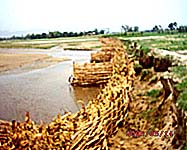
Figure15 : Bank protection by bamboo screens.
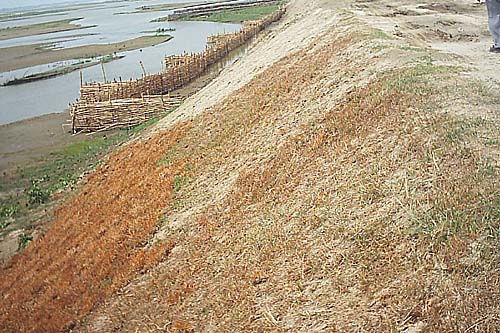
Figure 16 : Bamboo screens used as anti erosion measures for protecting earthen embankment.
When secondary channels are to be closed and longer structures are required, the porcupines are used. Figure 17 shows rows of porcupine units laid in position. At least three rows are to be provided at one location. A single permeable screen is not found to be effective.
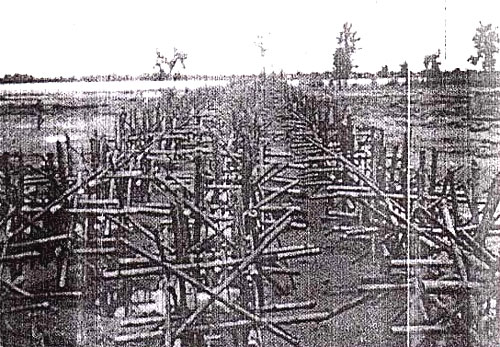
Figure 17 - three rows of porcupine units laid in position
Advantages of the Measures
The measures are more useful for a country like Nepal, where flood problems are wide spread and available funds are scarce. Some of the advantages of these measures are:
Simple, cheap and within the capacity of local community. The cost per km. of permeable structures is about NRs. 0.5 million as compared to NRs. 7.5 million of gabion anti erosion works.
It provides an opportunity to local community to identify local resources and techniques useful for mitigating flood disasters.
As the works are usually implemented through a committee formed from among the affected people, it provides them an opportunity to work in group and identify their strengths and weaknesses.
Conclusion
Disaster management in an organized form is new to Nepal, and therefore there is a lot of scope and need on building institutional capacity on mitigation, response and rehabilitation measures and thereby providing effective services to the affected people.
The demand on mitigation, emergency and rehabilitation works in Nepal far surpasses its resources locally available within the country and therefore support from donors is inevitable. Investment on disaster related works is usually cannot be justified on economic and financial benefits. A different approach incorporating social and environmental benefits with economic benefits should be adopted in making investment in disaster mitigation and management activities.
(Quotation literature: International Symposium on Utilization of Disaster Information~Organizing and Sharing Disaster Information in Asian Country~(JSECE Publication No.44), Copyright © The Japan Society of Erosion Control Engineering)